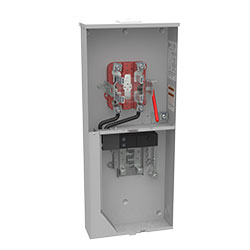Bypass or Disconnect: What’s the Difference?
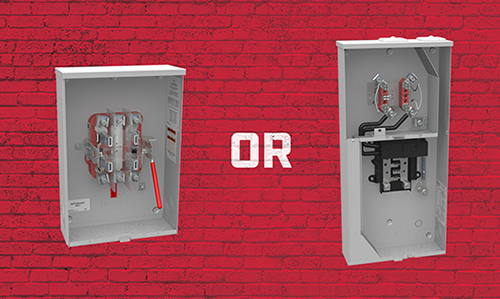
At first glance, it might seem like the bypass in a metering product does the same thing that a disconnect does, but both perform different functions. This quick rundown will help clear up some of those misconceptions regarding the two and assist in keeping you safer when using Milbank products.
A Bypass Redirects Power
What is the purpose of a bypass? If a utility worker needs to remove a meter to inspect it or replace it with a new meter when the power needs to stay on in the structure, they can apply or activate the bypass, which allows the house or building to remain energized while the power has been rerouted away from the meter. It is then safer for the worker to remove the meter once the power has taken the alternate path. In this situation, the homeowner can enjoy uninterrupted power in their home and the worker can safely do their maintenance work.
Milbank metering products have several different kinds of bypasses available including lever, horn and link bypass. First is the lever bypass. Maybe the most common misconception is that a lever bypass on the meter socket is intended to shut the power off to a structure. This is not the case! Instead the lever bypass redirects the power, taking it on an alternate path and bypassing the meter while the meter is temporarily removed from the meter socket. It is not a disconnect, which will be described below. To use a lever bypass, you simply move the lever into the up position to release the jaw clamping mechanism and get to work.
Other bypass options in our products include a horn or link bypass. For a horn bypass, the utility worker attaches one end of their special cable to the line side horn and the other to the load side horn of meter socket’s interior in order to activate the bypass. Link bypass is where the utility uses a special tool with an insulated handle to bridge—or link—across the line and load bussing attaching to studs on each, which creates an alternate path for the current. Different utilities and regions will have different requirements for the type of bypass used. The application can also affect requirements—most commercial applications will require a lever bypass, for example.
Here are a few examples of Milbank products with different types of bypass:
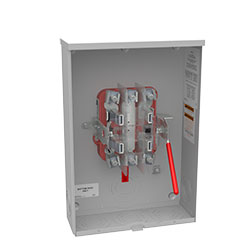
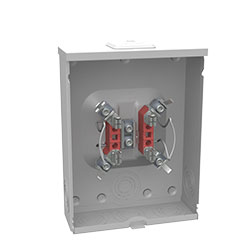
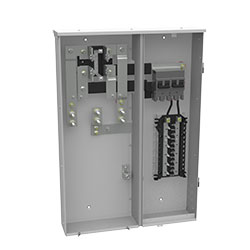
The Milbank product from left to right: U4801-O (lever bypass), U7040-XL-TG-KK (horn bypass), M400-UG-APS-LC-BS (link bypass)
Some metering products don’t come with a bypass at all. Again, it depends on the utility and region requirements.
A Disconnect Shuts Off Power
A disconnect provides the means of disconnecting power or cutting it off completely. This is also known as providing a means to safely open an electrical circuit. In the case of activating a disconnect, power is shut off to the building or structure.
There are different types of disconnects. In Milbank products, meter mains will contain a knife switch, breaker or fuse pull-out that cuts off power to the structure. If using a meter socket that has no disconnecting means in it, then you will typically locate the disconnect below the meter socket or inside the house or building on a breaker panel.
The NEC 2020 update to Section 230.85(1) addresses the proper methods of disconnecting a residence. Single- and two-position residential meter sockets will need to include an emergency disconnect on new builds and service upgrades. This means that a disconnect has to be included on the outside of a residential structure, allowing first responders in emergency situations to cut off the power without having to either wait for the utility to cut it off or go inside to cut off power.
To meet these requirements in areas adopting NEC 2020, new builds and service upgrades will have to either add a separate disconnect after the meter socket or use an all-in-one solution like a Milbank meter main that has the meter socket and disconnect in one enclosure.
Here’s an example of a disconnect in a Milbank meter main:
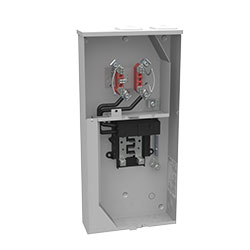
U5168-XTL-150 (main disconnect)
A Bypass and Disconnect Both in One Product
A bypass and disconnect are two different elements with two different functions, but they are not mutually exclusive. You can have a product that includes both a bypass and a disconnect in it! Because the two features have two different purposes, they can both be specified inside a single enclosure.
For example, the Milbank U6281 meter main series includes a breaker that disconnects power but also includes a lever that can bypass power without shutting it off completely.
Here is what a meter main with both a bypass and disconnect in one looks like:
U6281-XL-200 (with the lever bypass in the top compartment and the disconnect in the bottom)
Whether you’re in need of a certain kind of bypass, a disconnect or neither, Milbank offers metering products that cover all your bases. Get in touch with your local rep or one of our internal experts to help find the perfect utility-approved solution for your next project.
Want to keep reading up on technical terms? Check out our article on the difference between SCCR and AIC.
